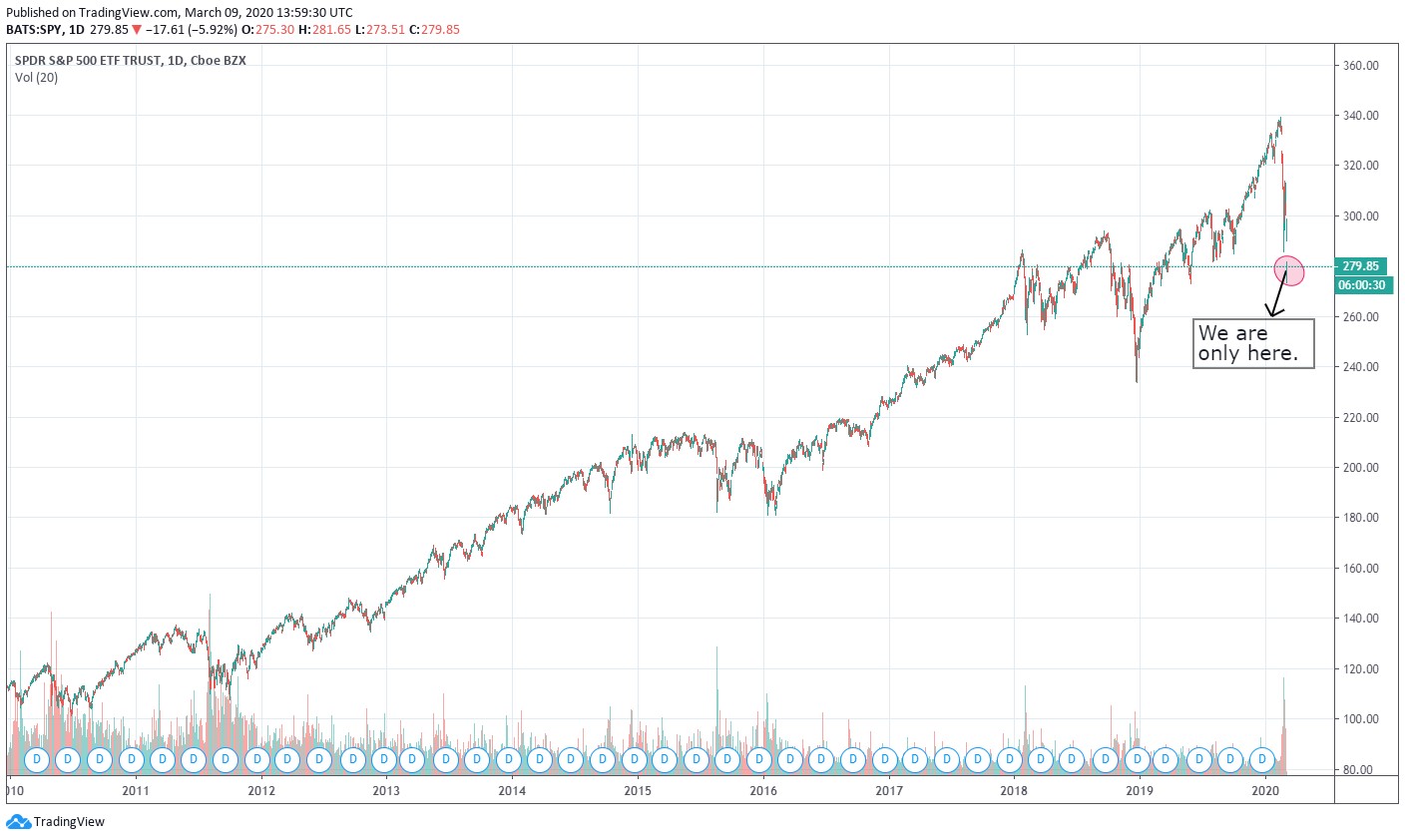S&P 500 Circuit Breakers Tripped, Dow Jones Opens Down 2,000+ Points

Image: The market remains under selling pressure, but the massive sell off the past couple weeks has only amounted to but a blip since the beginning of 2010. There could be more pain ahead.
By Brian Nelson, CFA
After a pre-market session March 9 that locked futures at “limit down” (futures are limited from dropping more than 5%), most investors were laser-focused on the moves of the S&P 500 ETF (SPY), which pre-market had been hovering around the $276 per-share range, off about 7%. Shortly after market open, circuit breakers were then tripped with the S&P 500 falling 7%, stopping trading for 15 minutes. The Dow Jones Industrial Average fell more than 2,000 points. We are maintaining our S&P 500 target range of 2,350-$2,750, or $235-$275 on the SPY at this time.
Both the Best Ideas Newsletter portfolio and Dividend Growth Newsletter portfolio have been well-positioned. For starters, prior to the collapse the past couple weeks, in August 2019, we had removed the Energy Select Sector SPDR (XLE) and the Financials Select Sector SPDR (XLF). In light of the recent news regarding oil-price wars and the Fed’s emergency 50 basis-point cut, a combination that will eat into both energy and banking profits, respectively, removing these ETFs from the newsletter portfolios turned out to be quite the timely move.
In January of this year, we removed both Apple (AAPL) and General Motors (GM) from the Best Ideas Newsletter portfolio and Dividend Growth Newsletter portfolio, and we went on the “defensive,” including adding Newmont Mining (NEM) to the Dividend Growth Newsletter portfolio at that time. Note Apple, a huge bellwether for the market, registered a 2 on the Valuentum Buying Index (1 is worst) on January 10, 2020, while shares were trading north of $310. Given Apple’s large weighting in broad market indices, we think the VBI was indicative of market trouble ahead at that time.
On February 24, we added “market crash protection,” layering on a deep out-of-the-money put option to protect against an ensuing market crash, which happened. At that time, we also removed Microsoft (MSFT) and Booking Holdings (BKNG) from the Dividend Growth Newsletter portfolio and Best Ideas Newsletter portfolio, respectively. On March 2, we closed the put-option protection for a nice simulated gain, and we re-established “crash protection” March 6, the Friday before today’s crash.
We have added new tools to help members navigate this market environment. We are now providing additional options commentary, which can be added to your membership here. For those looking to add hedging ideas without the application of options, please consider adding the Exclusive to your membership here. One of the latest ideas in the Exclusive shows how to hedge against market declines (without using options), and the Exclusive also offers one short-idea consideration each month. Of note, we recently closed a short-idea consideration that created a streak of 16 consecutive short-ideas working out for members from the inaugural edition in July 2016 and extending through October 2017.
Right now, we’re waiting and watching. Both the Best Ideas Newsletter portfolio and Dividend Growth Newsletter portfolio have nice 10%+ cash “weightings,” and with their put protection, they have held up relatively well in 2020 after a very strong year in 2019. While it may go without saying at this point, we expect the remainder of the trading session March 9 to continue to be volatile. We’ll be looking to close a few short-idea considerations in the Exclusive (email pending market conditions), but we don’t plan to make any moves today in either the Best Ideas Newsletter portfolio, Dividend Growth Newsletter portfolio, or High Yield Dividend Newsletter portfolio.
We’re available for any questions.
Please be sure to ask your financial advisor if options may be right for you. Derivatives trading is risky, can result in complete loss of premium (capital), and most options expire worthless.
0 Comments Posted Leave a comment